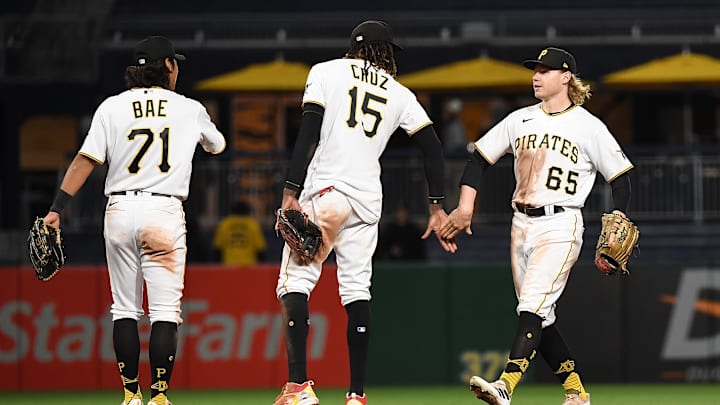Jack Suwinski
Jack Suwinski may be the Pirates' most underrated breakout candidate. The outfielder made a good first impression in 2022, showing off potential on both sides of the ball. Acquired in the Adam Frazier trade, Suwinski will be in a position he can perform better in during 2023 and may also benefit from the new rule changes.
Suwinski was about a league-average batter, slashing .202/.298/.411 with a .311 wOBA and 100 wRC+. Although Suwinski hit for solid power with a .209 isolated slugging percentage and walked at an above-average 11% rate, he also struck out 30.7% of the time. But a handful of things are working in his favor in 2023.
Suwinski was shifted on 71.2% of his trips to the plate. The outfielder had a 12.2% barrel rate, which was in the top 86th percentile of batters in 2022. Opponents often employed the shift that required an infielder to stand in shallow right field against Jack. Along with his ability to make quality contact combined with less extreme shifts, Suwinski may see an uptick in his .242 batting average on balls in play.
Another factor that should help him out is that the Pirates can hide his bat against left-handed pitching. Suwinski had an abysmal .122/.225/.286 line and 47 wRC+ against same-handed pitching. However, when he faced right-handed pitching, he hit .237/.330/.465 with a .344 wOBA and 122 wRC+. The additions of Connor Joe and Andrew McCutchen can help mitigate those large platoon splits.
Suwinski showed he can handle the outfield. He racked up +2 defensive runs saved and +1 out above average. The Pirates have given Suwinski a long look in center field this Spring, but while it might seem unconventional, it is the position he did his best at. Suwinski had +1 DRS and +1 OAA up the middle and has the speed to play center. He was in the top 84th percentile of sprint speed, making him faster than known speedsters like Ronald Acuna, Trevor Story, and Lorenzo Cain.
Suwinski may not be the best hitter on the team, but there's a chance for him to hit .230 with a well-above-average OBP and 20 home runs in 450 or so plate appearances. The factors that are working in his favor may end up being the reason he breaks out in 2023. The amount he strikes out at is still a tad worrying, but other factors considered, there are more positives for Suwinski than negatives.
